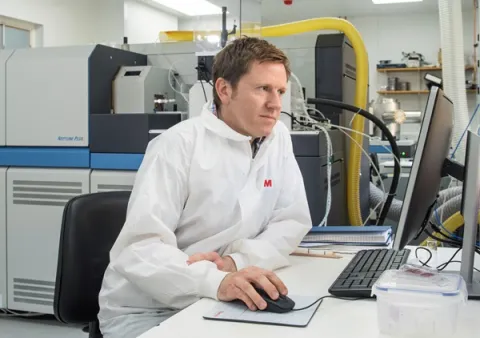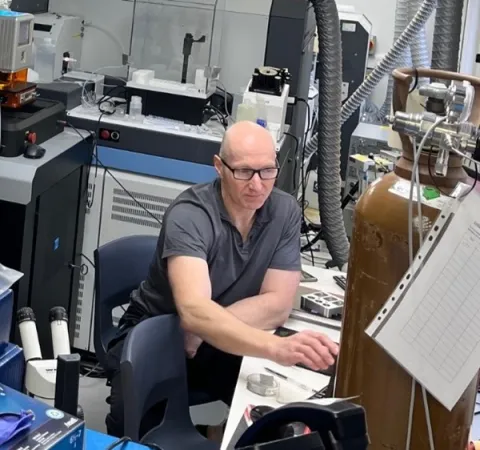Project overview
The geological past contains many examples of Earth’s climate being different to today and these are excellent test beds for our understanding of the climate system and ultimately our predictions of our future climate. Over the last 600 thousand years (kyr) or so, the Earth’s climate has regularly oscillated, roughly every 100 kyr, between warm “interglacial” periods with climates similar to today, and frigid “glacial” periods when several kilometres of ice blanketed North America and northern Europe (at times extending into Siberia). Bubbles of ancient air trapped in ice cores from Antarctica reveal that these cyclical changes in climate were partly driven by changes in the atmospheric concentration of the greenhouse gas carbon dioxide (CO2) – CO2 was low during glacial periods and high during intervening interglacial periods. During each ice age cycle, cooling towards peak glacial climates tended to be rather slow (taking around 90 kyr) whereas the warming that terminates each glacial period tended to be very quick (~10 kyr in length). However, before about 1.2 million years ago Earth’s climate was warmer on average, there was less ice on the continents and climate cycles were more regular, symmetric, and shorter – they followed a 41 kyr orbital beat at that time. Gradually between 1.2 and 0.6 million years ago, the character of glacial-interglacial cycles changed, shifting from these smaller 41-kyr cycles to the more recent larger 100-kyr cycles. Climate scientists have studied this important interval, known as the Mid Pleistocene Transition (MPT), for decades to learn about the inner workings of the climate system, but as yet the underlying cause remains debated.
Despite their contrasting character, these two types of climate cycle were both paced by subtle variations in the amount and the spatial and seasonal distribution of sunlight reaching the Earth’s surface as a result of regular changes in how the Earth orbits the sun (known as orbital cycles). What is puzzling is that the change in nature of the climate cycles occurred in the absence of any notable change in these orbital cycles. It therefore represents a fundamental change in the way the climate system operates and in particular how certain feedbacks behave when the climate system is subjected to forcing.
In order to test which, if any, of the available models adequately explains this transition we need reconstructions of both the size of the continental ice sheets and knowledge of the concentration of atmospheric CO2. While the evolution of ice volume through time is known relatively well, the direct ice core record of atmospheric CO2 only covers the last 800 thousand years and it is unlikely that it can be extended further back in the near future (if at all). We therefore have to use other, more indirect methods to reconstruct the CO2 content of the ancient atmosphere. One approach with a proven track record uses the boron (B) isotopic composition of calcareous microfossils called foraminifera, which steadily accumulate over time in deep-sea sediments. There are two naturally occurring isotopes of boron and the ratio of these two isotopes, 11B to 10B, in the shells of foraminifera reflects the acidity of the ocean surface when they lived, and from this it is possible to estimate atmospheric CO2 at that time. The principal aim of this proposal is to use this method to produce a record of CO2 for the last 1.3 million years that overlaps with the ice core CO2 record but then extends this back to cover the Mid Pleistocene Transition. Putting our current understanding of the MPT to the test in this way promises new insights into the coupling of climate change and the global carbon cycle, thereby also ultimately shedding light on how climate and polar ice sheets will respond to fossil fuel burning.
Despite their contrasting character, these two types of climate cycle were both paced by subtle variations in the amount and the spatial and seasonal distribution of sunlight reaching the Earth’s surface as a result of regular changes in how the Earth orbits the sun (known as orbital cycles). What is puzzling is that the change in nature of the climate cycles occurred in the absence of any notable change in these orbital cycles. It therefore represents a fundamental change in the way the climate system operates and in particular how certain feedbacks behave when the climate system is subjected to forcing.
In order to test which, if any, of the available models adequately explains this transition we need reconstructions of both the size of the continental ice sheets and knowledge of the concentration of atmospheric CO2. While the evolution of ice volume through time is known relatively well, the direct ice core record of atmospheric CO2 only covers the last 800 thousand years and it is unlikely that it can be extended further back in the near future (if at all). We therefore have to use other, more indirect methods to reconstruct the CO2 content of the ancient atmosphere. One approach with a proven track record uses the boron (B) isotopic composition of calcareous microfossils called foraminifera, which steadily accumulate over time in deep-sea sediments. There are two naturally occurring isotopes of boron and the ratio of these two isotopes, 11B to 10B, in the shells of foraminifera reflects the acidity of the ocean surface when they lived, and from this it is possible to estimate atmospheric CO2 at that time. The principal aim of this proposal is to use this method to produce a record of CO2 for the last 1.3 million years that overlaps with the ice core CO2 record but then extends this back to cover the Mid Pleistocene Transition. Putting our current understanding of the MPT to the test in this way promises new insights into the coupling of climate change and the global carbon cycle, thereby also ultimately shedding light on how climate and polar ice sheets will respond to fossil fuel burning.
Staff
Lead researchers
Other researchers
Collaborating research institutes, centres and groups
Research outputs
Nicola Kirby, Ian Bailey, David C. Lang, Anieke Brombacher, Thomas B. Chalk, Rebecca L. Parker, Anya J. Crocker, Victoria E. Taylor, James A. Milton, Gavin L. Foster, Maureen E. Raymo, Dick Kroon, David B. Bell & Paul A. Wilson,
2020, Quaternary Science Reviews, 250
Type: article
Elwyn De La Vega, Thomas B. Chalk, Paul A. Wilson, Ratna Priya Bysani & Gavin L. Foster,
2020, Scientific Reports, 10(1)
Type: article
Joseph A. Stewart, Steven J. Christopher, John R. Kucklick, Louise Bordier, Thomas B. Chalk, Arnaud Dapoigny, Eric Douville, Gavin L. Foster, William R. Gray, Rosanna Greenop, Marcus Gutjahr, Freya Hemsing, Michael J. Henehan, Philip Holdship, Yu‐te Hsieh, Ana Kolevica, Yen‐po Lin, Elaine M. Mawbey, James W. B. Rae, Laura F. Robinson, Rachael Shuttleworth, Chen‐feng You, Shuang Zhang & Russell D. Day,
2020, Geostandards and Geoanalytical Research
DOI: 10.1111/ggr.12363
Type: article
Marcus Gutjahr, Louise Bordier, Eric Douville, Jesse Farmer, Gavin L. Foster, Ed C. Hathorne, Bärbel Hönisch, Damien Lemarchand, Pascale Louvat, Malcolm Mcculloch, Johanna Noireaux, Nicola Pallavicini, James W.B. Rae, Ilia Rodushkin, Philippe Roux, Joseph A. Stewart, François Thil & Chen‐feng You,
2020, Geostandards and Geoanalytical Research
DOI: 10.1111/ggr.12364
Type: article
Elwyn De La Vega, Gavin Foster, Miguel A Martinez boti, Eleni Anagnostou, M. Paul Field, Minkwan Kim, Paul Watson & Paul A. Wilson,
2020, Rapid Communications in Mass Spectrometry, 34(11)
DOI: 10.1002/rcm.8762
Type: article
Christopher David Standish, Thomas Chalk, Tali Babila, James Milton, Martin Palmer & Gavin Foster,
2019, Rapid Communications in Mass Spectrometry, 33(10), 959-968
DOI: 10.1002/rcm.8432
Type: article
J. Yu, L. Menviel, Z. D. Jin, D. J. R. Thornalley, G. L. Foster, E. J. Rohling, I. N. Mccave, J. F. Mcmanus, Y. Dai, H. Ren, F. He, F. Zhang, P. J. Chen & A. P. Roberts,
2019, Nature Communications, 10(1)
Type: article


